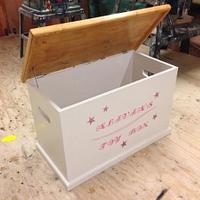Kelly
in over 11 years
I've Got An Angle
I needed some angle cuts that extended well past the limits of most protractors. I haven’t been in school for more than forty years and never took geometry or any other class beyond basic math. As such, playing with complex formulas or compasses (which are mostly small and no less limited than protractors) was not something I was wont to do. No doubt, many others are like me in that fact.
All these things said, I came up with a means of, very accurately, finding any angle. It does involve several steps, but my digital and other protractors indicated I was quite close in my measurements. In truth, I believe any inaccuracies were in projecting the line of the short (no longer than 12”) protractors, rather than my calculations/methods.
I will share the approach, of course, but I’d like to see how others got there, or would get there using just a ruler and a bit of mathematical rambling, at basic levels. I will say using pi is fair, though I did not. Again, I used only a ruler. Anyone want to weight in?
6 Replies
312 lbs. .. lol please tell us
Jeff Vandenberg aka "Woodsconsin"
With your line ran between the two legs, mark eight inch or other chosen increments on it for the forty-five degree marks.
When marking degree points, mark critical positions, such as 90, 72, 60, 45, 30 and 22-1/2 degrees for easy location in the future.
Using this, you can mark any angle accurately. You can use a chalk line to mark the angle, if desired.
Yeah, why the suspense?
I have one of those angle combination square doohickies from harbor freight. It has a 16" rule. If I wear glasses I can get pretty close to a 1/2 degree. That’s assuming this thing is accurate enough to matter. I cut pieces for a pyramid this past weekend and they came out pretty close. I was surprised, actually,
Another way I’ve done is to use a 12" speed square and mark the angle I want from the pivot point. That can work very well.
Then again you may have very accurately marked your angles and it doesn’t mean a hill of beans when it comes time to cut. LOL
Losing fingers since 1969
Part of the fun of this was, I worked with engineers at Bangor Sub Base, in Washington, years past. Because of the kind of work done there, there were a lot of math experts.
Interestingly, I gave MANY of them a simple math problem and everyone of them came up with the same answer – the hard way. When asked about it, none could think of a more simple way.
Goofing around looking for solutions, since I didn’t like theirs, I came up with one which worked better and was easier to use.
So it is with this problem. I knew there would be a solution that didn’t involve the forty-five minute trip (one way) to town to buy a calculator I’d use once, but I was hoping others could come up with something even more simple.
I may still need to build some simple tables for using different fractions and extending the legs, however. Unless someone comes up with an easy means of finding leg lengths for accurate angles.
My method works for anyone and can be done with a square or a ruler.
So far, those able to figure it out can’t without another year of math, or the calculator, it seems.
On a side note, the Angles I’m making are for furniture and musical instruments, so they must be accurate.
I started with a ninety degree angle, since it was the easiest to come by. All I had to do was use an L square, or measure 3,4 then 5 feet (measure three feet, turn, measure four feet, turn the same way and line the tape with where I started).
Once I had a ninety degree angle, I could get started, or go equal distance on each leg, measure the distance between the two points and split it in half for forty-five degrees.
Depending on how big the item was going to be, I could use eighth of an inch, quarters of an inch, halves or even larger fractions or whole numbers to represent each degree mark.
We know the entire angle is ninety degrees, so, if we use the ninety degree angle, we will need to use ninety of the chosen increments. If we used the forty-five degree angle, it would, of course, require we use forty-five of them.
Staying with the forty-five degree angle and choosing 1/8” increments, I will need a measurement 45/8th’s, (5”5/8”), which will be measured across the angle from two points that are an equal distance up the two legs of the 45.
It may take a couple runs, moving the line between the two legs up or down them, before you find the position which gives you your 5-5/8” distance.
Once you find the points that will give you the 5-5/8” distance, you can double it, rather than resort to trial and error again. You could also make a chart, which I will, giving the measurements for extended points.
With your line ran between the two legs, mark eight inch increments on it for the forty-five degree marks. Mark critical positions, such as 90, 72, 60, 45, 30 and 22-1/2 degrees for easy location in the future.
Using this, you can mark any angle accurately. You can, then, use Paul’s chalk line to mark your angle.
I found this useful for setting up to run 2x’s for ten degree angle cuts.
and working in the area I know the angle will be, eventually, drawn,
THE formula, which, at 3:00 a.m., was to be published, but only got partially published:
I started with a ninety degree angle, since it was the easiest to come by. All I had to do was use an L square, or measure 3,4 then 5 feet (measure three feet, turn, measure four feet, turn the same way and line the tape with where I started).
Once I had a ninety degree angle, I could get started, or go equal distance on each leg, measure the distance between the two points and split it in half for forty-five degrees.
Depending on how big the item was going to be, I could use eighth of an inch, quarters of an inch, halves or even larger fractions or whole numbers to represent each degree mark.
We know the entire angle is ninety degrees, so, if we use the ninety degree angle, we will need to use ninety of the chosen increments. If we used the forty-five degree angle, it would, of course, require we use forty-five of them.
Staying with the forty-five degree angle and choosing 1/8” increments, I will need a measurement 45/8th’s, (5”5/8”), which will be measured across the angle from two points that are an equal distance up the two legs of the 45.
It may take a couple runs, moving the line between the two legs up or down them, before you find the position which gives you your 5-5/8” distance.
Once you find the points that will give you the 5-5/8” distance, you can double it, rather than resort to trial and error again. You could also make a chart, which I will, giving the measurements for extended points.
With your line ran between the two legs, mark eight inch increments on it for the forty-five degree marks. Mark critical positions, such as 90, 72, 60, 45, 30 and 22-1/2 degrees for easy location in the future.
Using this, you can mark any angle accurately. I found this useful for setting up to run 2x’s for ten degree angle cuts.
I just use a datum point, use a little bit of trigonometry to measure 2 points at right angles from the datum point, join the two new points with a line for the final angle.
I used to use a Zeus book for the calculations (previous precision engineer) but have found a great app for the iPhone call ‘triangle calculator’ that removes the confusion of trig maths.
I-Got-Wood











